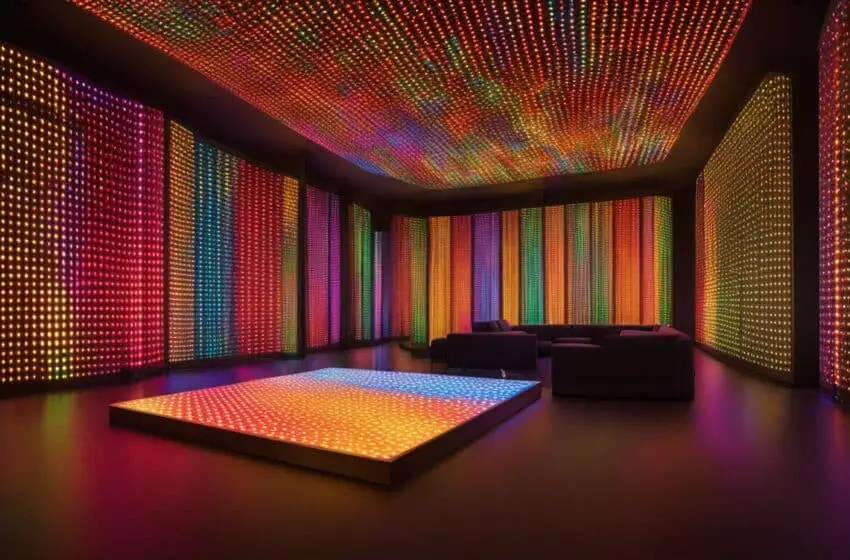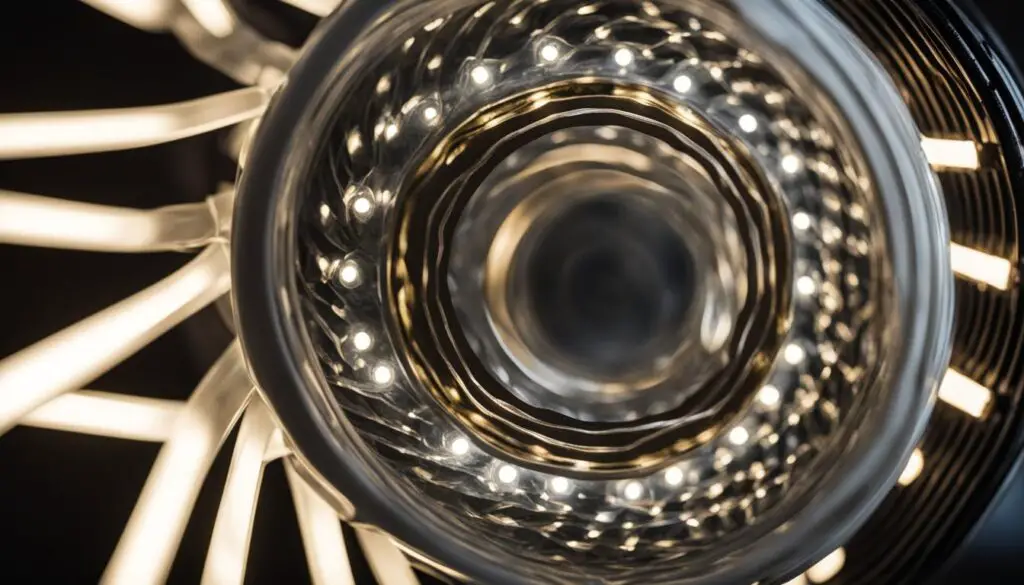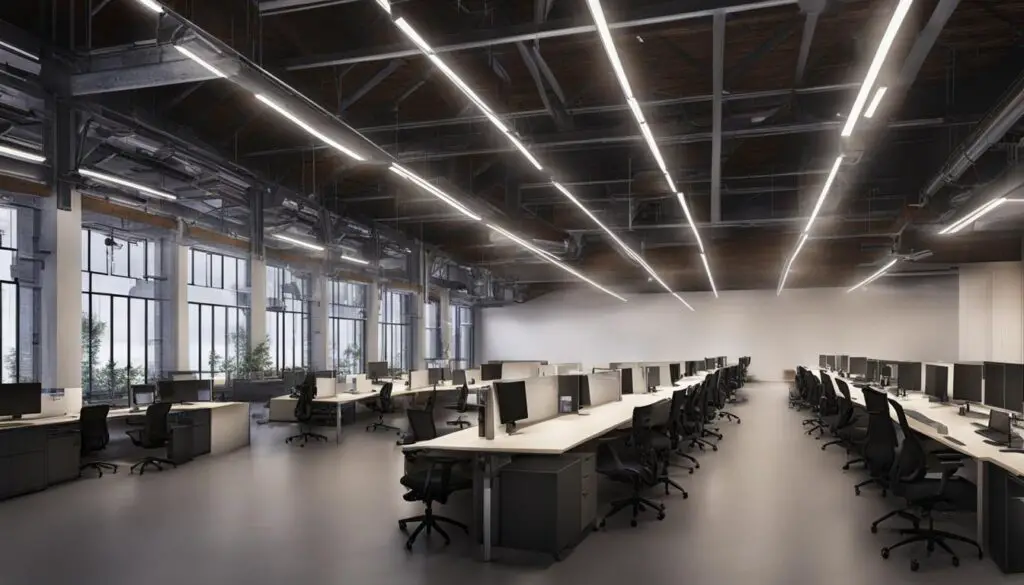LED Technology Advancements: Brighter and More Efficient

LED lighting technology has made significant strides in recent years, resulting in brighter and more efficient lighting options. With these advancements, LEDs have become the most energy-efficient choice available, offering long-lasting performance and superior light quality compared to other lighting alternatives.
LEDs have the potential to revolutionize the future of lighting, especially in residential settings. In fact, residential LED lights use approximately 75% less energy and can last up to 25 times longer than traditional incandescent lighting. The widespread adoption of LED technology could lead to immense energy savings, with projections indicating potential annual savings of up to 569 TWh by 2035. To put this into perspective, that’s equivalent to the energy output of more than 92 1,000 MW power plants.
Key Takeaways:
- LED lighting technology has advanced significantly, resulting in brighter and more efficient lighting options.
- LEDs are the most energy-efficient lighting choice, offering long-lasting performance and superior light quality.
- Residential LEDs use approximately 75% less energy and can last up to 25 times longer than incandescent lighting.
- Potential annual energy savings of up to 569 TWh by 2035 are projected through widespread LED adoption.
- LED technology has the potential to revolutionize the future of lighting, providing a brighter and more sustainable future.
Energy Savings and Environmental Impact
LED lighting is highly energy-efficient, offering substantial savings in energy consumption compared to traditional lighting options. Residential LEDs, especially those with ENERGY STAR ratings, use at least 75% less energy than incandescent lighting. Additionally, LEDs can last up to 25 times longer, reducing the need for frequent bulb replacements. This energy efficiency can have a significant impact on the environment, with LED lighting installations projected to save 569 TWh of energy annually by 2035. This level of energy savings is equivalent to the annual energy output of more than 92 1,000 MW power plants, resulting in a substantial reduction in greenhouse gas emissions.
To illustrate the impact of LED energy savings, refer to the table below:
| Type of Lighting | Energy Savings Compared to Incandescent Lighting | Lifespan |
|---|---|---|
| LED Lighting | At least 75% less | Up to 25 times longer |
| Incandescent Lighting | N/A | 1,000-2,000 hours |
As shown in the table, LED lighting offers significant energy savings, with a lifespan that far surpasses that of incandescent lighting. By replacing traditional lighting sources with LED technology, individuals and businesses can contribute to reducing energy consumption and the associated environmental impact. In addition to energy savings, LED lighting also offers other benefits such as reduced maintenance costs and improved light quality.
LED lighting provides substantial energy savings and has a positive impact on the environment. By adopting LED technology, we can reduce greenhouse gas emissions and move towards a more sustainable future.
Key Differences of LED Lighting
LED lighting stands out from other types of lighting, such as incandescent and CFL, due to several key differences. Understanding these differences is crucial in recognizing the unique features and benefits that LED lighting offers.
Smaller Size and Color Versatility
LEDs are much smaller in size compared to traditional lighting options. This compact size allows for greater versatility in lighting design, making LEDs suitable for various applications from residential to commercial settings.
Moreover, LED lighting can emit light in a wide range of colors. This color versatility allows for dynamic lighting solutions, enabling users to adjust the lighting ambiance according to their preferences and needs.
Directional Light Emission
Unlike other lighting options, LEDs emit light in a specific direction. This directional light emission eliminates the need for additional reflectors and diffusers, making LEDs more efficient in terms of light output.
LEDs are particularly beneficial in applications such as recessed downlights and task lighting, where focused illumination is required. The ability to emit light in a specific direction ensures maximum efficiency and targeted lighting.
Low Heat Emission and Energy Efficiency
One of the notable advantages of LED lighting is its low heat emission. Unlike traditional incandescent and CFL bulbs, which waste a significant amount of energy through heat, LEDs produce very little heat.
This reduced heat emission contributes to the energy efficiency of LEDs. By minimizing energy loss through heat, LED lighting can allocate more power to generate light, resulting in higher efficiency and reduced energy consumption.
Extended Lifespan
LED lighting products generally have a significantly longer lifespan compared to traditional options. LED bulbs can last three to five times longer than CFL bulbs and up to 30 times longer than incandescent bulbs.
This extended lifespan translates to reduced maintenance and replacement costs. With LED lighting, users can enjoy long-lasting illumination without the hassle of regularly changing bulbs.
Overall, LED lighting distinguishes itself through its smaller size, color versatility, directional light emission, low heat emission, energy efficiency, and extended lifespan. These features make LED lighting a highly attractive choice for a wide range of applications, providing both aesthetic appeal and practical benefits.

Applications of LED Lighting
LED lighting offers a wide range of applications in both residential and industrial settings. The high efficiency and directional emission of LEDs make them ideal for various purposes. Here are some key applications of LED lighting:
Industrial Lighting
LEDs are extensively used in industrial settings for their exceptional performance and energy efficiency. From street lights to parking garage lighting, LEDs provide bright and reliable illumination, enhancing safety and security. Outdoor area lighting, such as floodlights and pathway lights, benefit from the directional emission of LEDs, ensuring focused illumination where it is needed most. Additionally, LEDs are used for refrigerated case lighting, maintaining optimal lighting conditions and minimizing energy consumption.
LED Replacement Bulbs
LED replacement bulbs are a popular choice for homeowners seeking a cost-effective and energy-efficient alternative to traditional incandescent bulbs. LED bulbs are available in various wattages and offer long-lasting illumination, reducing the need for frequent replacements. With their superior energy efficiency and extended lifespan, LED replacement bulbs provide significant cost savings over time.
LED Holiday Lights
LED holiday lights have gained popularity due to their numerous advantages. They consume significantly less electricity compared to traditional incandescent lights, resulting in lower energy costs. LED holiday lights also have a reduced risk of combustion, making them safer to use. Their durability ensures they can withstand harsh weather conditions, providing long-lasting enjoyment for multiple holiday seasons. Additionally, LEDs are easier to install, saving time and effort during decorating.
With their versatility and numerous benefits, LED lighting solutions continue to revolutionize various industries and provide sustainable lighting options for residential use.

| Applications | Benefits |
|---|---|
| Industrial Lighting | – High efficiency – Directional emission – Enhanced safety and security |
| LED Replacement Bulbs | – Energy efficiency – Long lifespan – Cost savings |
| LED Holiday Lights | – Lower energy costs – Reduced risk of combustion – Durability and longevity |
Advancements in LED Technology
LED technology continues to evolve at a rapid pace, resulting in even more efficient and brighter lighting options. The latest developments in LED lighting have led to the creation of ultra-efficient LED lamps and tubes that offer significant energy savings. These ultra-efficient LEDs can save up to 60% more energy and last three to five times longer than traditional options.
One particularly impressive feature of ultra-efficient LED lighting is its ability to deliver up to 210 lumens per watt. This high level of brightness ensures excellent illumination while minimizing energy consumption. For large consumers such as industries, warehouses, offices, and public buildings, these ultra-efficient LEDs provide substantial energy savings.
Despite the higher initial purchase price of ultra-efficient LED lamps, their long-term benefits make them a viable and cost-effective option. By opting for ultra-efficient LED lighting solutions, large-scale consumers can significantly lower their electricity bills and reduce greenhouse gas emissions, contributing to a more sustainable future.
Here is a comparison table showcasing the energy savings and lifespan of ultra-efficient LED lamps compared to traditional options:
| LED Lamp | Energy Savings (%) | Lifespan (times longer) |
|---|---|---|
| Ultra-efficient LED | Up to 60% | 3-5 times longer |
| Traditional Option | N/A | 1 time |
To visualize the advancements in LED technology, take a look at the following image:
As you can see, ultra-efficient LED lighting not only provides energy savings but also offers a longer lifespan, reducing the need for frequent replacements. This combination of efficiency and durability makes ultra-efficient LED lamps an excellent choice for both businesses and individuals looking to reduce their environmental impact and save on energy costs.
The Future of LED Lighting: Human-Centric and IoT
The future of LED lighting is poised for remarkable advancements with the integration of human-centric lighting and the Internet of Things (IoT). These innovations promise to revolutionize how we experience and interact with lighting in our everyday lives.
Human-centric LED lighting takes into account the importance of light on our well-being and productivity. By incorporating features like color tuning, LED lights can mimic the natural circadian rhythms of the human body, promoting better sleep patterns and enhancing our overall health and well-being. Additionally, human-centric LED lighting can be equipped with dimmable and occupancy sensing capabilities, optimizing energy efficiency by adjusting lighting levels based on occupancy and natural light availability.
The IoT-enabled LED lighting takes the capabilities of LED lights to the next level by enabling connectivity and communication between lighting fixtures and other internet-enabled devices. This opens up a world of possibilities for creating smart buildings and smart cities, where LED lights can seamlessly interact with various systems and devices. For example, IoT-enabled LED lighting can work in tandem with sensors to optimize lighting levels based on occupancy or provide real-time feedback on energy consumption. It also allows for remote control and monitoring, making it easier to manage and maintain lighting systems.
One exciting technology that is emerging in the realm of LED lighting is LiFi. LiFi, or Light Fidelity, utilizes LED lights to transmit data, providing high-speed internet connectivity through visible light. This technology has the potential to revolutionize how we access the internet, especially in commercial spaces and offices where reliable and secure internet connections are crucial. LiFi-enabled LED lighting can create a network of light that enhances connectivity without interfering with existing radio frequency signals, making it an attractive option for the future of wireless communication.
As we venture into the future, the integration of human-centric lighting and IoT-enabled LED lighting will transform the way we illuminate our surroundings. From personalized lighting experiences to interconnected smart systems, LED lighting will not only provide efficient and sustainable illumination but also enhance our quality of life and drive technological advancements forward.
Conclusion
LED technology advancements have revolutionized the lighting industry, offering brighter and more efficient lighting options with significant energy savings. LEDs have become the go-to choice for residential and industrial applications, providing long-lasting, energy-efficient, and environmentally friendly lighting solutions.
The future of LED lighting holds even more promise, with developments in human-centric lighting, IoT integration, and LiFi technology. These advancements will continue to drive energy savings, enhance lighting experiences, and expand the capabilities of LED lighting in various sectors.
As LED technology continues to evolve, it is essential to stay updated on the latest advancements and explore the benefits of LED lighting for a brighter and more sustainable future.
FAQ
What are the benefits of LED lighting technology?
LED lighting technology offers significant advantages, including energy efficiency, long lifespan, and superior light quality compared to other lighting options. LEDs use less energy, last longer, and emit less heat, resulting in energy savings and reduced environmental impact.
How do LEDs compare to traditional lighting options?
LEDs differ from traditional lighting options in various ways. They emit light in a specific direction, eliminating the need for reflectors and diffusers. LEDs also last much longer than incandescent and CFL bulbs and emit very little heat. Additionally, LED bulbs are available in a range of colors and sizes, providing versatility in different applications.
Where can LED lighting be used?
LED lighting has a wide range of applications, both in residential and industrial settings. LED technology is commonly used for street lights, parking garages, outdoor area lighting, refrigerated case lighting, task lighting, and as replacements for traditional incandescent bulbs. LED holiday lights are also popular for their energy efficiency and durability.
What advancements have been made in LED technology?
LED technology continues to advance rapidly, resulting in more efficient and brighter lighting options. Ultra-efficient LED lamps and tubes have been developed, offering up to 60% energy savings and lasting three to five times longer than traditional options. These advancements have made LED lighting an attractive choice for large-scale consumers.
What is the future of LED lighting?
The future of LED lighting involves the introduction of human-centric lighting and IoT integration. Human-centric LED lighting aims to create optimal lighting environments by mimicking natural circadian rhythms and incorporating dimmable or occupancy sensing capabilities. IoT-enabled LED lighting allows for connectivity and communication between LED lights and other internet-enabled devices, enabling smarter buildings and potentially providing high-speed internet connectivity through LiFi technology.
What are the advantages of LED lighting?
LED lighting offers numerous advantages, including energy savings, longer lifespan, superior light quality, and reduced environmental impact. With advancements in LED technology, it provides brighter and more efficient lighting options, making it a sustainable and cost-effective choice for various applications.



